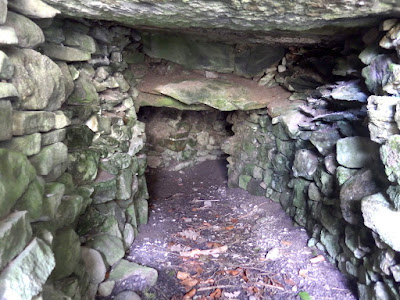My 92 year old mother had never been to Newgrange, so another visit there was a necessity!
A UNESCO World Heritage Site, Brú na Boinne is a collection of ancient passage graves north of the Boyne River, i.e., an ancient cemetery. The largest of the passage graves are found at Newgrange, Knowth and Dowth. Newgrange and Knowth are accessible only via an impressive visitor centre, and the visitor must take the buses provided to the site in order to see them. It is a visit totally worth taking, but arrive early as tickets are limited and sold on a first-come first-serve basis. (The only way tickets can be reserved in advance are if you go on an officially organised tour.)
The entrance to Newgrange (above) is fronted by the most amazing megalith.
The chief archaeologist at Knowth did not subscribe to Professor MJ O'Kelly's take on the quartz and river-rolled rocks found in front of the largest mound there. As can be seen below, the rocks were left as they were found at Knowth (below) in comparison to O'Kelly's speculative reconstruction design of Newgrange's facade.
The entrance megalith to Knowth isn't as impressive as that at Newgrange (though impressive nonetheless!) and unfortunately due to building in another historical era, the passage is not accessible as it is at Newgrange.
Knowth is an amazing site, and I highly recommend that a visitor see both it and Newgrange, as there are different things about each that are unique. Knowth's mound is larger and has many satellite grave mounds beside it. Knowth alone holds 30% of all megalithic art found in Europe.
The large mound at Knowth has an impressive amount of visible decorated stones. Here are three!
Before heading back to our base in Drogheda, we stopped by Dowth, where we had never been. My Mum stayed napping in the car, which was just as well as the mound is surrounded by a flock of sheep and the resulting mine field of their droppings! But without other tourists this place is extra special -- this burial site pre-dates the pyramids and Stonehenge. The mound is quite large, with some evidence that there has been an internal collapse of some sort. Only a few of the megalithic kerbstones are visible but following their trajectory one can imagine the location of the others below ground level (raised by time's sediment).
Post passage grave builders at Knowth and on this site, built souterrains for food storage and for protection.
A souterrain at Knowth precludes development of the passage grave for visitors, but the souterrain at Dowth is in a different spot from its entrance. It is barred however (presumably for public safety as Dowth is an open site) but one can peek through the bars at the structure of the passage grave. Having been inside Newgrange, it is easy enough to imagine the end chambers to which this would lead.











No comments:
Post a Comment